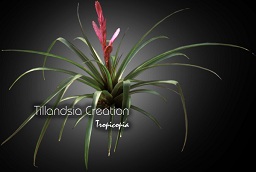Table of contents
Tillandsia Creation

Latin Name: Tillandsia Creation
Category: Bromeliad
Family: Bromeliaceae
Origin: Hybrid
Climate: Tropical humid
Growing Zones: 11-10
Care Instructions
The Tillandsia Creation (Tillandsia Creation) is a tropical humid plant that originates from Hybrid. This bromeliad plant belongs to the Bromeliaceae family and is well-suited for growing in USDA zones 11-10.
Complete Care Guide for Tillandsia Creation
Watering Requirements
Tillandsia, commonly known as air plants, have unique watering requirements that differ significantly from traditional houseplants. These plants do not require soil and absorb moisture and nutrients through their leaves. It is essential to water them thoroughly by soaking them in room temperature water for about 20-30 minutes once a week. In drier climates or during the summer months, you may need to increase the frequency to twice a week. After soaking, gently shake off any excess water and place them upside down on a towel for a few hours to ensure they dry completely. This prevents water from accumulating in the base of the leaves, which can lead to rot. Remember, overwatering is a common mistake, so always err on the side of caution.
Light Conditions
Tillandsia thrive in bright, indirect light. They can tolerate some direct sunlight, especially in the morning or late afternoon, but prolonged exposure to harsh sunlight can scorch their leaves. Ideally, place your air plants near a window with filtered light or in a well-lit room. If you notice the leaves turning brown or crispy, it may be a sign of too much direct sunlight. Conversely, if the leaves appear elongated and pale, they may not be receiving enough light. In low-light conditions, consider using grow lights to provide the necessary illumination for healthy growth.
Soil Preferences
One of the most fascinating aspects of Tillandsia is that they do not require soil to grow. Instead, they can be mounted on various surfaces such as wood, rocks, or in terrariums. If you choose to use a substrate, opt for a well-draining medium like orchid bark or a specialized air plant soil mix. Fertilization is also crucial for their health; use a bromeliad or air plant fertilizer diluted to half strength every 4-6 weeks during the growing season (spring and summer). This will provide the necessary nutrients that they would typically absorb from the environment in their natural habitat.
Pests and Diseases
While Tillandsia are generally resilient, they can still be susceptible to pests such as mealybugs and aphids. Regularly inspect your plants for any signs of infestation, such as white cottony masses or sticky residue on the leaves. If you notice pests, gently wipe them off with a soft cloth or use a cotton swab dipped in rubbing alcohol. For more severe infestations, consider using an insecticidal soap. Additionally, ensure proper air circulation around your plants to prevent fungal diseases, which can occur if they remain damp for too long. If you notice any signs of rot, such as mushy leaves, remove the affected areas immediately to prevent the spread.
Special Care Tips
To keep your Tillandsia healthy and thriving, consider the following special care tips. First, ensure that your air plants are not placed in enclosed terrariums without ventilation, as they require good air circulation. Additionally, during the winter months, when indoor heating can dry out the air, you may need to mist your plants more frequently to maintain humidity levels. Another great practice is to rotate your air plants occasionally to ensure even light exposure on all sides. Lastly, if you notice your plants blooming, be sure to provide extra care during this time, as they will need more water and nutrients to support the flowering process. With these tips, your Tillandsia will flourish and bring beauty to your space.








